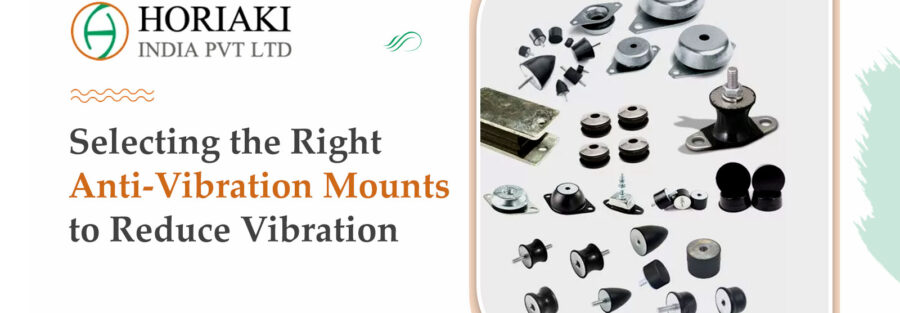Selecting the Right Anti-Vibration Mounts to Reduce Vibration
Understanding and capitalizing on the benefits of anti-vibration mounts is critical for both OEMs and industrial users. This blog explains how to select the appropriate AV rubber mounts.
Why Do You Need Anti-Vibration Mounts?
AV mounts are small components that are installed on heavy machinery and equipment to limit the amount of noise and vibration transmitted through the machine.
When heavy machinery is in operation, it produces vibrations and noise. With time, the noise and vibration begin to harm the equipment. You may discover that your machine is no longer efficient, or that it requires more repairs and replacement; worse, it may finally fail.
Effects of Vibration on your machines:
- It can damage the machine’s vibration-sensitive controls and panels.
- Loosening screws, gears, bearings, and bolts can lead to increased repair and maintenance expenses.
- Loss of production due to low outputs, damaged component finish, accuracy, and part tolerance.
- Noise, shock, and vibrations can be transmitted throughout the building.
- Damage to flooring and structural components.
- Malfunctions, errors, and altered alignment/calibration of sensitive and precision equipment.
- Operator discomfort and a dangerous job environment lead to worker fatigue.
Anti-vibration mounts are installed on the machines to reduce the amount of vibration, shock, and noise. These mounts function by transferring vibration and noise from the gadget and directing it elsewhere. Using an appropriate AV mount will help you minimize the harmful effects of vibration and noise on your equipment. It can also help prolong the life of your equipment.
So, how do you choose the Anti-Vibration Mounts?
1. Determine the equipment’s weight and load distribution.
The first step is to identify the weight of the equipment to be mounted. The equipment’s weight will determine the size, kind, and number of rubber mountings required. Determine the total weight (kg) of the equipment/machinery and the number of mountings that will be needed. The heavier the overall weight, the more AV mounts are required to decrease machine vibrations.
2. Determine the weight distribution for each mounting.
Keep in mind that the machinery’s weight may not be evenly distributed. Furthermore, overall machinery weight must take into account the weight of all operating components, tools, and dies. For example, if the machinery weighs 800 kg, you’ll need four anti-vibration mounts with a load-bearing capability of 200 kg each to spread the weight equally.
Check the center of gravity to ensure even weight distribution, since various sites may need mounts with differing load capabilities.
3. Determine the equipment’s vibration profile
Identify the vibration profile of the equipment, including frequency, amplitude, and RPM. Determine the usual operational speed of the machinery or RPM (revolutions per minute), also known as the forcing frequency, and the lowest operating speed (generally at idle), which determines the amount of vibration created by the equipment/machinery. The stresses and moments created by this RPM will determine the type of anti-vibration mounts required to reduce vibrations.
4. Determine the operating or application environment.
Consider the operational circumstances and where the equipment will be installed. Analyze your application requirements – whether you want to install your equipment outside or within buildings, on roofs, ceiling mounted, floor mounted, or in any other location.
Temperature, humidity, industrial chemicals, cleaning solvents, and harsh factors can all have an impact on the efficiency of your anti-vibration rubber mounting. Choose a rubber mounting that is specifically engineered to operate well in your equipment’s operational environment. The type of rubber chosen depends on the environmental conditions.
5. Consider the Type of Anti-Vibration Mounts
Options for anti-vibration rubber mountings include vibration insulation plates, wedge mounts, screw support mounts, and stud mounts, among others. The type of AV mounts you select will be determined by the equipment’s vibration profile and damping needs. Vibration dampening and impact load resistance have an inverse connection depending on the natural frequency of anti-vibration rubber mounts.
A lower natural frequency improves vibration dampening but reduces impact load resistance, and vice versa. Furthermore, the shape, size, and substance of vibration isolators vary, giving clients a wide selection to pick from.
6. Consider the maintenance requirements.
Finally, check the anti-vibration mounts’ maintenance requirements. Some mountings require more care than others, so select one that meets your needs. For example, certain mountings may need to be tightened or lubricated on a regular basis, whilst others may not.
Conclusion:
Selecting the appropriate anti-vibration mounts is crucial for maintaining the longevity, stability, and production effectiveness of any industrial equipment. If you need expert help selecting the best anti-vibration rubber mounting, contact Horaiki India Pvt. Ltd.


